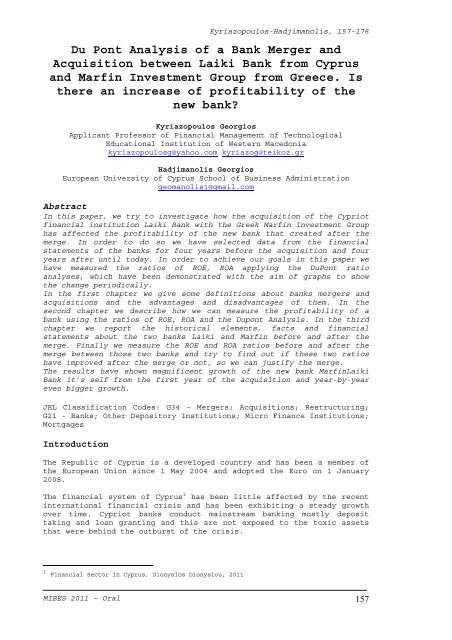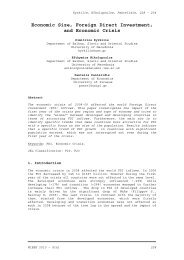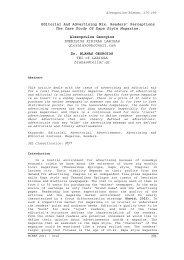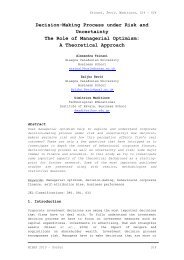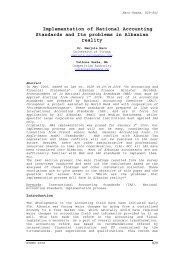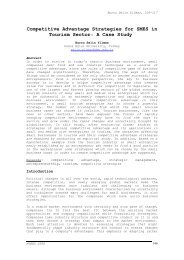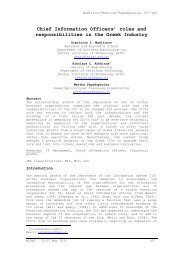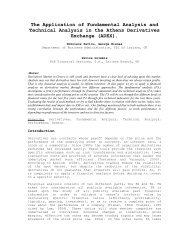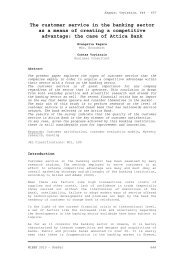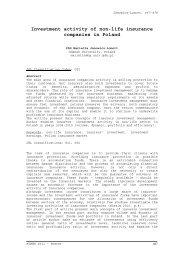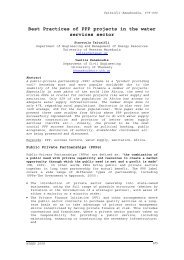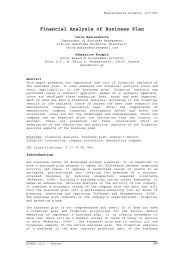Du Pont Analysis of a Bank Merger and Acquisition between ... - mibes
Du Pont Analysis of a Bank Merger and Acquisition between ... - mibes
Du Pont Analysis of a Bank Merger and Acquisition between ... - mibes
Create successful ePaper yourself
Turn your PDF publications into a flip-book with our unique Google optimized e-Paper software.
Kyriazopoulos-Hadjimanolis, 157-176<br />
<strong>Du</strong> <strong>Pont</strong> <strong>Analysis</strong> <strong>of</strong> a <strong>Bank</strong> <strong>Merger</strong> <strong>and</strong><br />
<strong>Acquisition</strong> <strong>between</strong> Laiki <strong>Bank</strong> from Cyprus<br />
<strong>and</strong> Marfin Investment Group from Greece. Is<br />
there an increase <strong>of</strong> pr<strong>of</strong>itability <strong>of</strong> the<br />
new bank?<br />
Kyriazopoulos Georgios<br />
Applicant Pr<strong>of</strong>essor <strong>of</strong> Financial Management <strong>of</strong> Tech nological<br />
Educational Institution <strong>of</strong> Western Macedonia<br />
kyriazopoulosg@yahoo.com kyriazog@teikoz.gr<br />
Hadjimanolis Georgios<br />
European University <strong>of</strong> Cyprus School <strong>of</strong> Business Ad<br />
geomanolis1@gmail.com<br />
ministration<br />
Abstract<br />
In this paper, we try to investigate how the acquis ition <strong>of</strong> the Cypriot<br />
financial institution Laiki <strong>Bank</strong> with the Greek Mar fin Investment Group<br />
has affected the pr<strong>of</strong>itability <strong>of</strong> the new bank that created after the<br />
merge. In order to do so we have selected data from the financial<br />
statements <strong>of</strong> the banks for four years before the a cquisition <strong>and</strong> four<br />
years after until today. In order to achieve our go als in this paper we<br />
have measured the ratios <strong>of</strong> ROE, ROA applying the D u<strong>Pont</strong> ratio<br />
analyses, which have been demonstrated with the aim <strong>of</strong> graphs to show<br />
the change periodically.<br />
In the first chapter we give some definitions about banks mergers <strong>and</strong><br />
acquisitions <strong>and</strong> the advantages <strong>and</strong> disadvantages o f them. In the<br />
second chapter we describe how we can measure the p r<strong>of</strong>itability <strong>of</strong> a<br />
bank using the ratios <strong>of</strong> ROE, ROA <strong>and</strong> the <strong>Du</strong>pont An alysis. In the third<br />
chapter we report the historical elements, facts an d financial<br />
statements about the two banks Laiki <strong>and</strong> Marfin bef ore <strong>and</strong> after the<br />
merge. Finally we measure the ROE <strong>and</strong> ROA ratios be fore <strong>and</strong> after the<br />
merge <strong>between</strong> those two banks <strong>and</strong> try to find out i f these two ratios<br />
have improved after the merge or not, so we can jus tify the merge.<br />
The results have shown magnificent growth <strong>of</strong> the ne w bank MarfinLaiki<br />
<strong>Bank</strong> it’s self from the first year <strong>of</strong> the acquisiti on <strong>and</strong> year-by-year<br />
even bigger growth.<br />
JEL Classification Codes: G34 - <strong>Merger</strong>s; Acquisitio<br />
G21 - <strong>Bank</strong>s; Other Depository Institutions; Micro F<br />
Mortgages<br />
ns; Restructuring;<br />
inance Institutions;<br />
Introduction<br />
The Republic <strong>of</strong> Cyprus is a developed country <strong>and</strong> h<br />
the European Union since 1 May 2004 <strong>and</strong> adopted the<br />
2008.<br />
as been a member <strong>of</strong><br />
Euro on 1 January<br />
The financial system <strong>of</strong> Cyprus<br />
1 has been little affected by the recent<br />
international financial crisis <strong>and</strong> has been exhibit ing a steady growth<br />
over time. Cypriot banks conduct mainstream banking mostly deposit<br />
taking <strong>and</strong> loan granting <strong>and</strong> this are not exposed t o the toxic assets<br />
that were behind the outburst <strong>of</strong> the crisis.<br />
1 Financial Sector In Cyprus, Dionysios Dionysiou, 20 11<br />
MIBES 2011 – Oral 157
Kyriazopoulos-Hadjimanolis, 157-176<br />
However the excessive lending following the Euro ad<br />
increased exposure to the real estate market <strong>and</strong> th<br />
<strong>and</strong> economic crisis <strong>and</strong> prudential regulation led t<br />
credit expansion.<br />
option, led to<br />
e World financial<br />
o a containment <strong>of</strong><br />
The total consolidated assets <strong>of</strong> the banking sector were around 9 times<br />
as high as GDP at the end <strong>of</strong> December 2010, even th ough the above ratio<br />
is not giving correctly the overall picture, as it includes the<br />
following:<br />
• Loans <strong>and</strong> bonds booked in Cyprus which is funded by the parent<br />
institution <strong>and</strong> credit risk remains also with the h olding company,<br />
which were mainly booked in Cyprus for tax purposes .<br />
• A bank is a subsidiary <strong>of</strong> a non EU government contr ol banking<br />
institution.<br />
• If the above assets are excluded, then the size <strong>of</strong> the banking<br />
sector is significantly reduced to almost 2/3 <strong>of</strong> th e above<br />
percentage. Moreover 30% <strong>of</strong> the said assets are in the form <strong>of</strong><br />
liquid assets which bear a low credit risk.<br />
•<br />
Cypriot banks are well capitalised, with a solvency ratio <strong>of</strong> 12.2%<br />
(December 2010), which is well above the regulatory minimum <strong>of</strong> 8%.<br />
There is an adequate coverage <strong>of</strong> non performing loa ns by provisions<br />
made by the banks; the significant capital buffer a vailable over <strong>and</strong><br />
above the regulatory minimum could absorb additiona l unforeseen losses<br />
potentially arising as a result <strong>of</strong> the current cris is.<br />
The Central <strong>Bank</strong> <strong>of</strong> Cyprus can provide emergency li quidity assistance<br />
for illiquid but solvent banks; however, collateral is required.<br />
Chapter 1 <strong>Merger</strong>s & <strong>Acquisition</strong>s<br />
23<br />
By the introduction <strong>of</strong> the new millennium <strong>and</strong> the e urozone area, banks<br />
in the Europe <strong>and</strong> all over the world started to und erst<strong>and</strong> that a<br />
cooperative work could lead to higher customer sati sfaction <strong>and</strong> for the<br />
companies bigger pr<strong>of</strong>its. So financial institutions in order to compete<br />
into an aggressive market was showing its dynamics but the main<br />
principle behind banking mergers <strong>and</strong> acquisitions a re to reap the<br />
benefits <strong>of</strong> economies <strong>of</strong> scale <strong>and</strong> increase the sha reholders wealth. In<br />
other words, banks seek to achieve significant grow th in their<br />
operations (i.e. growth <strong>of</strong> customer base) <strong>and</strong> minim ize their expenses<br />
to a considerable extent <strong>and</strong> try to increase the RO E ratio that leads<br />
in raise <strong>of</strong> the wealth <strong>of</strong> the shareholders. As a re sult, we see a new<br />
merger or acquisition in the banking systems global ly very <strong>of</strong>ten. First<br />
we would like to separate the meanings <strong>of</strong> mergers a nd acquisitions even<br />
though most <strong>of</strong> the times we treat them as having th e same meaning.<br />
<strong>Merger</strong> is when two banks, agree to go forward as a single company while<br />
in an <strong>Acquisition</strong> a bank takes over another bank an d clearly the<br />
accurate bank established as the new owner. In the banking system we<br />
have horizontal merger, which means two different c ompanies involved in<br />
the same kind <strong>of</strong> business or commercial activities join. Another type<br />
<strong>of</strong> merger we see in the banking market is cross-bor der merger, which<br />
means one company from one-country join forces with one in another<br />
country. By doing this global banking corporations are able to place<br />
themselves into a dominant position in the banking sector, achieve<br />
economies <strong>of</strong> scale, as well gain market share, but the main goal remain<br />
the increase <strong>of</strong> the wealth <strong>of</strong> the shareholders. The whole difference is<br />
the atmosphere that exists <strong>between</strong> the high manager ial stuff after the<br />
union happens. In a merger all staff from both exis ting banks agrees on<br />
2 <strong>Merger</strong>s <strong>and</strong> acquisitions in the banking sector, Eco nomywatch.com, March 2011.<br />
3<br />
The impact <strong>of</strong> banks’ mergers <strong>and</strong> acquisitions on th eir staff employment <strong>and</strong><br />
effectiveness, John Mylonakis, 2006.<br />
MIBES 2011 – Oral 158
Kyriazopoulos-Hadjimanolis, 157-176<br />
the union while in an acquisition one company takes over the other by<br />
buying stock or by cash <strong>and</strong> the high managerial sta ff don’t really find<br />
it satisfying. The apex financial authority <strong>of</strong> a pa rticular country<br />
controls all mergers <strong>and</strong> acquisitions that happen i n the banking<br />
sector.<br />
<strong>Merger</strong>s <strong>and</strong> acquisitions in the baking system usual ly goes together<br />
with new technologies since it is easier <strong>and</strong> less c ostly for banks to<br />
introduce new technologies when they work together <strong>and</strong> the new<br />
technologies can be introduced in a more efficient manner. An example<br />
<strong>of</strong> new technology might be the internet banking. In ternational<br />
experience research detects the important quantitat ive <strong>and</strong> qualitative<br />
consequences <strong>of</strong> mergers <strong>and</strong> acquisitions in employm ent.<br />
Some consequences <strong>of</strong> a merger might be:<br />
• Decrease in the employment <strong>of</strong> less specialized cate gories.<br />
• Important changes in the role <strong>of</strong> enterprise senior staff towards<br />
more complex <strong>and</strong> more flexible duties.<br />
• A relative increase in the employment <strong>of</strong> specialize d <strong>and</strong> younger<br />
staff. Companies are relieved <strong>of</strong> less specialized o r/<strong>and</strong> older<br />
excess staff through early or voluntary retirement programs.<br />
• Serious incorporation <strong>and</strong> compatibility problems am ong the various<br />
management systems, industrial relations <strong>and</strong> organi zation <strong>of</strong> work.<br />
(Georgakopoulou,2000)<br />
These factors require careful preparation <strong>and</strong> may b ecome crucial for a<br />
successful merger when deriving from different nego tiation systems,<br />
collective regulation <strong>and</strong> definition <strong>of</strong> payment <strong>and</strong> labor terms.<br />
1.1. Advantages <strong>and</strong> disadvantages <strong>of</strong> bank merges an d acquisitions 456<br />
a. Some main advantages <strong>of</strong> M&A could be:<br />
• Economies <strong>of</strong> scale <strong>and</strong> <strong>of</strong> purpose.<br />
• Tax benefits.<br />
• Replacement <strong>of</strong> inefficient, in the wide competitive environment, in<br />
specialized issues management <strong>and</strong> confrontation <strong>of</strong> the increased<br />
competition.<br />
• Maximization <strong>of</strong> shareholders' return.<br />
• Infiltration into new markets <strong>and</strong> their exploitatio n more easily.<br />
• Reduction <strong>of</strong> risk using new techniques <strong>of</strong> managing financial risk.<br />
• The exploitation <strong>of</strong> the comparative advantage <strong>and</strong> t he acquisition <strong>of</strong><br />
oligopoly power.<br />
• Creation <strong>of</strong> a new commercial logo <strong>and</strong> the supply <strong>of</strong> products <strong>and</strong><br />
services at a competitive cost <strong>and</strong> high added value .<br />
• More efficient confrontation <strong>of</strong> the phenomenon <strong>of</strong> d isintermediation.<br />
b. Some main disadvantages <strong>of</strong> M&A could be:<br />
• The difficulties that arise for the personnel <strong>of</strong> th e merged banks to<br />
get acquainted with the new fellow workers, the new policies <strong>and</strong> the<br />
new procedures.<br />
• Jealousies <strong>and</strong> internal competition as well as fric tions that <strong>of</strong>ten<br />
take place among the staff members <strong>of</strong> the merged ba nks.<br />
• There is a possibility that the reduction <strong>of</strong> the pe rsonnel <strong>and</strong><br />
equipment as a result <strong>of</strong> the merger will be damagin g.<br />
4 “<strong>Merger</strong>s <strong>and</strong> <strong>Acquisition</strong>s <strong>and</strong> the Altman’s Z-score Model for <strong>Bank</strong>ruptcy” Kyriazopoulos,<br />
G., Petropoulos, D., ICOAE Athens 2010<br />
5 Explaining the M&A-success in European bank mergers <strong>and</strong> acquisitions, Patrick Beitel,<br />
Dirk Schiereck, <strong>and</strong> Marc Wahrenburg, April 2003.<br />
6 <strong>Merger</strong>s <strong>and</strong> acquisitions <strong>and</strong> bank performance in Eu rope, the role <strong>of</strong> strategic<br />
similarities, Yener Altunbas, David Marques Ibanez, October 1994.<br />
MIBES 2011 – Oral 159
Kyriazopoulos-Hadjimanolis, 157-176<br />
• In some instances <strong>of</strong> mergers there will be required , new logos, new<br />
writing material, new forms or publications, <strong>and</strong> th us new stocks for<br />
expendable supplies <strong>and</strong> equipment items that alread y exist at an<br />
additional cost.<br />
• The uncertainty with regards to the approval <strong>of</strong> the merger by the<br />
proper authorities.<br />
• The possibility that the bank that will be created after the merger<br />
will have surplus personnel in some departments or positions. For<br />
example, it is possible to take place a necessary d oubling <strong>of</strong><br />
specialists in matters <strong>of</strong> foreign exchange markets, in matters <strong>of</strong><br />
personnel training etc.<br />
• A possible overoptimistic projection for the size o f pr<strong>of</strong>itability<br />
that will result from the combination <strong>of</strong> operations <strong>of</strong> the merged<br />
banks will have as a result the buying bank to pay an exorbitant<br />
price for the bank being bought out.<br />
• In many cases, the returns <strong>of</strong> the share <strong>of</strong> the bank s that made<br />
buyouts <strong>of</strong> other banks were lower than the return o f the sector as a<br />
whole.<br />
• High social cost because it is usually observed a r eduction in<br />
employment resulting from lying <strong>of</strong> personnel.<br />
In a merger <strong>and</strong> acquisition situation Markowitz (19 52) considers two<br />
rules while starting a new portfolio optimization m odel for the<br />
investor. First the investor does (or should) maxim ize expected<br />
returns, <strong>and</strong> secondly the investor does (or should) consider expected<br />
return a desirable thing <strong>and</strong> variance <strong>of</strong> return an undesirable thing.<br />
Even though a merger <strong>and</strong> acquisition might be consi dered a relatively<br />
good move in the competitive market, facts prove th at many times it can<br />
have a bad impact in the staff employed by the orga nizations. As an<br />
example, I bring the case <strong>of</strong> merger <strong>and</strong> acquisition in Hellenic bank<br />
market, which in the period <strong>of</strong> 1998 – 2003 had 3,62 7 jobs canceled<br />
after the dem<strong>and</strong> <strong>of</strong> the shareholders to have dem<strong>and</strong> limitations in the<br />
number <strong>of</strong> employed staff (Mylonakis, 2006).<br />
With the introduction <strong>of</strong> one single market for fina<br />
later on after the introduction <strong>of</strong> euro, an unprece<br />
financial consolidation has taken place in the Euro<br />
the late 1990’s the number <strong>of</strong> mergers <strong>and</strong> acquisiti<br />
with the introduction <strong>of</strong> Monetary Union. According<br />
academics the process <strong>of</strong> banking integration seems<br />
<strong>and</strong> is expected to continue in the following years.<br />
forces underpinning this consolidation process, suc<br />
rapid technological advances <strong>and</strong> financial globaliz<br />
to exist.<br />
ncial services, <strong>and</strong><br />
dented process <strong>of</strong><br />
pean Union. <strong>Du</strong>ring<br />
ons had increased<br />
to bankers <strong>and</strong><br />
far from completed<br />
First many <strong>of</strong> the<br />
h us the effect <strong>of</strong><br />
ation will continue<br />
Although banking assets as a percentage <strong>of</strong> GDP grew from 177.2% in 1985<br />
to 244.2% in 1997 (European Central <strong>Bank</strong> 1999) the number <strong>of</strong> European<br />
banks decreased from 12,670 in 1985 to 8,395 in 199 9 (European Central<br />
<strong>Bank</strong> 2000). This development is mostly driven by me rgers <strong>and</strong><br />
acquisitions among European banks. As a consequence , the European (EU-<br />
15) market concentration measured by the market sha re <strong>of</strong> the top 5<br />
banks in terms <strong>of</strong> total assets (CR5) grew by 12 per centage points over<br />
the last 10 years to 57.1% in 1999. Second, the num ber <strong>of</strong> financial<br />
institutions per 1,000 inhabitants in the European Union is doubled<br />
than that in the United States <strong>of</strong> America, suggesti ng that there is<br />
room for consolidation in the European Union. Third , there is a<br />
considerable degree <strong>of</strong> heterogeneity across Europea n Union countries in<br />
terms <strong>of</strong> concentration <strong>of</strong> banks.<br />
The impact <strong>of</strong> bank consolidation on the transmissio<br />
is a multidimensional issue. According to most empi<br />
n <strong>of</strong> monetary policy<br />
rical studies, an<br />
MIBES 2011 – Oral 160
Kyriazopoulos-Hadjimanolis, 157-176<br />
increase in banking concentration tends to drive lo an rates up, in many<br />
local markets thereby probably hampering, to some e xtend, the passthrough<br />
from market to bank lending rates. On the o ther h<strong>and</strong>, in terms<br />
<strong>of</strong> quantities, early concerns about loan supply res trictions to small<br />
<strong>and</strong> medium enterprises arising from bank concentrat ion seem to have<br />
been exaggerated. The results <strong>of</strong> the studies indica te a significant<br />
improvement in efficiency from bank mergers <strong>and</strong> acq uisitions.<br />
Parallel to empirical studies, literature that uses event study<br />
methodology, that typically tries to ascertain whet her the announcement<br />
<strong>of</strong> the bank merger creates shareholder value for th e target, have an<br />
underlying hypothesis that excess returns around an nouncement day could<br />
explain the creation <strong>of</strong> value associated to the mer ger.<br />
Recent studies have provided an interesting contrib ution by subsampling<br />
the population <strong>of</strong> merging banks, according to product or<br />
market relatedness, to analyse whether certain shar ed characteristics<br />
among merging institutions could create or destroy shareholder value or<br />
performance. By <strong>and</strong> large, the main conclusion <strong>of</strong> t hese studies is that<br />
while mergers among banks showing substantial eleme nts <strong>of</strong> geographical<br />
or product relatedness create value, dissimilarities tend to destroy<br />
overall shareholder value.<br />
The geographic focus <strong>of</strong> a transaction in a domestic transaction<br />
provides a higher synergy potential (e.g., more cos t savings) than<br />
cross-border transactions thus being able to create value easier <strong>and</strong><br />
also more underst<strong>and</strong>able for capital markets. Almos t all studies that<br />
cover the geographic focus <strong>of</strong> a transaction conclud e that more<br />
shareholder value is created when target bidder ope rate in a related<br />
geographical region.<br />
The relative size <strong>of</strong> a target (the impact <strong>of</strong> the ta rget’s size on the<br />
M&A-success) in relation to a bidder <strong>of</strong> the acquisi tion <strong>of</strong> smaller<br />
targets is less complex <strong>and</strong> although scale effects may be smaller,<br />
capturing existing value creation potential may be easier. However, the<br />
larger the target the larger possible synergies (th rough scale<br />
economies) may be. Thus the acquisition <strong>of</strong> targets that provide for<br />
sufficient synergies but still are <strong>of</strong> a manageable size should have a<br />
positive impact on value creation.<br />
The growth focus <strong>of</strong> a transaction is considered as being growth focused<br />
if a bidder acquires a target with a strong growth rate. M&Atransactions<br />
<strong>of</strong>ten are considered as means for stim ulating growth <strong>and</strong><br />
thus the acquisition <strong>of</strong> a fast growing target suppo rts the growth <strong>of</strong> a<br />
bidder even more.<br />
The risk reduction potential <strong>of</strong> a transaction is me asured by the<br />
correlation coefficient <strong>of</strong> the stock market returns <strong>of</strong> target <strong>and</strong><br />
bidder returns during the estimation period <strong>of</strong> the event study. The<br />
lower the correlation coefficient, the higher the d iversification/risk<br />
reduction potential <strong>of</strong> a transaction is. It is expe cted that<br />
diversifying transactions smoothen earnings volatil ity <strong>and</strong> thus provide<br />
for more certainty in stock returns. According to p opular management<br />
theories, this may have a positive impact on value creation. On the<br />
other h<strong>and</strong>, diversifying transactions may suffer fr om the conglomerate<br />
discount due to the stock market preference for “pu re play” stocks.<br />
MIBES 2011 – Oral 161
Kyriazopoulos-Hadjimanolis, 157-176<br />
1.2 Quantitative factors 7<br />
In all mergers <strong>and</strong> acquisitions primary factor is t<br />
buying has to pay for the other. The quantitative f<br />
under primary consideration are:<br />
• Current Pr<strong>of</strong>its<br />
• Current stock price<br />
• Logistic Accounts<br />
• Net Capital movement<br />
There are more factors that can’t be measured in qu<br />
excuse the high selling price while the quantitativ<br />
lower selling price.<br />
he price the one<br />
actors that are<br />
antitatively that<br />
e factors indicate a<br />
1.3 <strong>Du</strong>e Diligence Process 8910<br />
<strong>Du</strong>e diligence is a generally accepted method in und ertaking an<br />
assessment <strong>of</strong> potential M&A targets. Sinickas (2004 ) defines due<br />
diligence as “where each party tries to learn all i t can about the<br />
other party to eliminate misunderst<strong>and</strong>ing <strong>and</strong> ensur e the price is<br />
appropriate”. Angwin (2001) identifies due diligenc e as critical in M&A<br />
process. This author points out that effective due diligence should be<br />
a comprehensive analysis <strong>of</strong> the target company’s en tire business, not<br />
just an analysis <strong>of</strong> their cash flow <strong>and</strong> financial s tability as has<br />
traditionally been the case.<br />
It is one <strong>of</strong> the most critical elements in the succ ess <strong>of</strong> a merger <strong>and</strong><br />
acquisition transaction. It is a two-way street: Bu yers must underst<strong>and</strong><br />
what they are buying; <strong>and</strong> targets must underst<strong>and</strong> w ho’s pursuing them<br />
<strong>and</strong> whether they should accept an <strong>of</strong>fer. For a succ essful conduct <strong>of</strong><br />
due diligence, it should have senior management inv olvement <strong>and</strong> control<br />
<strong>and</strong> <strong>of</strong>ten assisted by outside experts such us manag ement consulting<br />
firms. <strong>Du</strong>e Diligence process is an analysis <strong>of</strong> outs t<strong>and</strong>ing surety<br />
liability <strong>and</strong> related indemnity matters which are a ll critical<br />
considerations during M&A. Surety bonds are credit instruments that are<br />
backed by corporate guarantees in the form <strong>of</strong> indem nity agreements.<br />
Sometimes from the company is required to provide c ollateral to further<br />
support the surety requirements.<br />
The <strong>Du</strong>e Diligence process covers four specific area s: (a) Impact <strong>of</strong> the<br />
indemnity agreement; (b) The transfer <strong>of</strong> surety lia bility; (c)<br />
Disruption to program management; <strong>and</strong> (d) Underwrit ing <strong>and</strong> credit<br />
elements. The goal <strong>of</strong> this analysis is to identify <strong>and</strong> address<br />
potential issues prior to the transaction closing d ate <strong>and</strong> help the<br />
parties affected from the purchase/sale agreement u nderst<strong>and</strong> how these<br />
issues can effect the transaction.<br />
As an instrument through which we reveal <strong>and</strong> remedy potential sources<br />
<strong>of</strong> risk, due diligence enables firms to formulate r emedies <strong>and</strong><br />
solutions to enable a deal to proceed. Clearly it i s easier to obtain<br />
high-quality data if the deal is friendly; in unfri endly deals due<br />
diligence may never progress further than publicly available data. This<br />
lack <strong>of</strong> access to internal information has scupper many a deal-for<br />
7 The advantages <strong>and</strong> disadvantages <strong>of</strong> mergers <strong>and</strong> acq uisitions in banks in Global <strong>and</strong><br />
Greek economy, Kyriazopoulos Georgios, Zissopoulos Dimitrios, Sariannidis Nikolaos, ESDO<br />
2009<br />
8 Planning for a successful merger or acquisition: Le ssons from an Australian study,<br />
Jarror McDonald, Max Coulthard, <strong>and</strong> Paul de Lange, 2005<br />
9 Surety <strong>Merger</strong> & <strong>Acquisition</strong>, <strong>Du</strong>e Diligence, Douglas R. Wheeler.<br />
10 <strong>Du</strong>e Diligence Requirement in Financial Transactions , Scott Moeller, 2007<br />
MIBES 2011 – Oral 162
Kyriazopoulos-Hadjimanolis, 157-176<br />
example, the takeover attempt by Sir Philip Green o<br />
2004.<br />
Each industry has its own special due diligence req<br />
case <strong>of</strong> a bank it would require a review <strong>of</strong> its mak<br />
risk management systems. <strong>Du</strong>e diligence also exp<strong>and</strong>s<br />
• Financial <strong>Du</strong>e Diligence<br />
• Legal <strong>Du</strong>e Diligence<br />
• Commercial <strong>Du</strong>e Diligence<br />
• Innovation <strong>Du</strong>e Diligence<br />
• Management <strong>Du</strong>e Diligence<br />
• Cultural <strong>Du</strong>e Diligence<br />
• Ethical <strong>Du</strong>e Diligence<br />
• Risk Management <strong>Du</strong>e Diligence<br />
In the following study we also try to investigate t<br />
Laiki <strong>Bank</strong> after the acquisition with Marfin Invest<br />
rename <strong>of</strong> the company to Marfin Popular <strong>Bank</strong>.<br />
f Marks& Spencer in<br />
uirements, in the<br />
ing policies <strong>and</strong><br />
into:<br />
he impact it had on<br />
ment Group <strong>and</strong> the<br />
Chapter 2 Pr<strong>of</strong>itability <strong>and</strong> <strong>Du</strong><strong>Pont</strong> <strong>Analysis</strong><br />
The pr<strong>of</strong>itability <strong>of</strong> the banking sector, has improv ed significantly in<br />
the first seven years <strong>of</strong> the new millennium before the crisis start up.<br />
This was a result <strong>of</strong> the general reform <strong>of</strong> the bank ing system (write<br />
<strong>of</strong>f <strong>of</strong> non-performing loans, privatization <strong>of</strong> state -owned banks, the<br />
introduction <strong>of</strong> modern banking techniques, credit e xpansion, <strong>and</strong> the<br />
introduction <strong>of</strong> the euro) <strong>and</strong> the high intermediati on spread in these<br />
countries. 11 In the future, the financial institutions should f ind<br />
different sources <strong>of</strong> pr<strong>of</strong>itability, since the inter mediation spread is<br />
expected to fall as the economies stabilize, the in terest rates fall<br />
<strong>and</strong> the competition among banks increase. The finan cial institutions<br />
should seek for these new sources <strong>of</strong> pr<strong>of</strong>itability in the retail<br />
banking <strong>and</strong> the asset management, while they should try to increase<br />
their market share. On the other h<strong>and</strong> they should c ontrol their<br />
operating expenses <strong>and</strong> exp<strong>and</strong> their activities quit e careful, in order<br />
to minimize their losses from bad loans.<br />
The analysis <strong>of</strong> the financial statements <strong>of</strong> a busin ess<br />
includes besides the selection <strong>of</strong> the appropriate i ndex <strong>and</strong><br />
the comparison, without which the resulting conclus ions do not<br />
have any meaning <strong>and</strong> most probably they do not lead to the<br />
correct explanation. The comparison makes sense whe n it is<br />
done in relation to time <strong>and</strong> in relation to the sim ilar<br />
businesses or the sector. This double comparison gi ves the<br />
capability <strong>of</strong> a more correct explanation <strong>of</strong> the ind exes <strong>and</strong><br />
consequently <strong>of</strong> the business condition (Papoulias, 2000).<br />
Pr<strong>of</strong>itability <strong>of</strong> banks is measured mainly by two ra tios. The Return on<br />
Equity (ROE) that increase the wealth <strong>of</strong> the shareh olders <strong>and</strong> the<br />
Return on Assets (ROA) that show to the investors h ow cable is the bank<br />
management to yield earnings <strong>and</strong> how pr<strong>of</strong>itably use the hole assets <strong>of</strong><br />
the bank.<br />
2.1 Return on Equity ROE<br />
121314<br />
This index reflects the efficiency with which the b<br />
<strong>of</strong> its owners, as it shows the size <strong>of</strong> pr<strong>of</strong>its that<br />
ank uses the capital<br />
were created by the<br />
11 “Does the Cross Border <strong>Merger</strong>s <strong>and</strong> <strong>Acquisition</strong>s <strong>of</strong> t he Greek <strong>Bank</strong>s in the Balkan area<br />
affect on the course <strong>of</strong> pr<strong>of</strong>itability efficiency an d liquidity indexes <strong>of</strong> them”?<br />
Kyriazopoulos G., Petropoulos D., EBEEC Pitesti 201 1<br />
12 Vasiliou D., Financial Management Patra 1999<br />
13 Financial <strong>Analysis</strong> <strong>of</strong> banking institutions, K. Selv avinayagam, 1995.<br />
14 Applied principles <strong>of</strong> finance, Woolridge, J. R<strong>and</strong>a ll <strong>and</strong> Gray, Gary, 2006.<br />
MIBES 2011 – Oral 163
Kyriazopoulos-Hadjimanolis, 157-176<br />
capital that was invested by the shareholders (owne rs) <strong>of</strong> the bank<br />
enterprise. This ratio relates pr<strong>of</strong>it earned after tax by the bank to<br />
resources contributed by its owners (K.Selvavinayag am, 1995). Return on<br />
Equity (ROE) measures the rate <strong>of</strong> return on the own ership interest. It<br />
measures a firm’s efficiency on generating pr<strong>of</strong>its from every unit <strong>of</strong><br />
shareholder’s equity. Finally, ROE shows how well a company uses<br />
investment funds to generate earnings growth. The e quation for finding<br />
ROE is as follow:<br />
ROE = Net Pr<strong>of</strong>its / Total Equity (2)<br />
Analyzing the specific index <strong>of</strong> efficiency <strong>of</strong> the s<br />
equity, we can find out if the purpose <strong>of</strong> achieving<br />
result has succeeded.<br />
(1)<br />
hareholders total<br />
a satisfactory<br />
2.2 Return on Assets (ROA)<br />
1516<br />
This index reflects the administrations capability to use efficiently<br />
the financial resources (assets) that has at its di sposition, in order<br />
to create pr<strong>of</strong>its.<br />
This ratio <strong>of</strong>ten described as the primary ratio, re lates the<br />
income earned by the bank to the resources employed by it.<br />
Normally ‘return’ is taken as pr<strong>of</strong>it before extraor dinary<br />
items, since these items fall outside the scope <strong>of</strong> the bank’s<br />
normal operations. This does not mean that extraord inary items<br />
should be ignored by the analyst, but that their si gnificance<br />
should be assessed as a separate exercise from the analysis <strong>of</strong><br />
the bank’s performance (K.Selvavinayagam, 1995).<br />
Return on Assets (ROA) ratio show us how pr<strong>of</strong>itable a bank’s assets are<br />
in generating revenue. It is a useful number for co mparing competing<br />
banks in the same countries. The equation for findi ng ROA is as follow:<br />
ROA = Net Pr<strong>of</strong>its / Total Assets. (4)<br />
Analyzing the specific index we could:<br />
• Compare the efficiency among the co-operative banks .<br />
• Observe the efficiency through time.<br />
(3)<br />
15 Does the Cross Border <strong>Merger</strong>s <strong>and</strong> <strong>Acquisition</strong>s <strong>of</strong> t he Greek <strong>Bank</strong>s in the Balkan area<br />
affect on the course <strong>of</strong> pr<strong>of</strong>itability efficiency an d liquidity indexes <strong>of</strong> them”?<br />
Kyriazopoulos G., Petropoulos D., EBEEC Pitesti 201 1<br />
16 Principles <strong>of</strong> Accounting, Susan V. Crosson; Belverd E., Jr Needles,Powers Marian, 2008.<br />
MIBES 2011 – Oral 164
Kyriazopoulos-Hadjimanolis, 157-176<br />
• Compare efficiency <strong>of</strong> co-operative banks with the e fficiency <strong>of</strong> the<br />
banking sector as a whole.<br />
• Investigate the reasons <strong>of</strong> the changes through time .<br />
2.3 The <strong>Du</strong>pont <strong>Analysis</strong> 17 , 18 , 19 , 20 , 21<br />
The <strong>Du</strong><strong>Pont</strong> system <strong>of</strong> financial analysis can be used to construct a<br />
financial plan for the bank. The <strong>Du</strong><strong>Pont</strong> system <strong>of</strong> f inancial analysis<br />
provides a means for the firm to monitor performanc e through the<br />
planning period <strong>and</strong> to post-audit the planning proc ess.<br />
<strong>Du</strong><strong>Pont</strong> comes from <strong>Du</strong><strong>Pont</strong> Corporation that started u sing this<br />
formula in 1920s. <strong>Du</strong><strong>Pont</strong> ratio analysis breaks down ROA (Return<br />
on Assets) <strong>and</strong> ROE (Return on Equity) into three ba sic<br />
components that determine pr<strong>of</strong>it efficiency, asset efficiency<br />
<strong>and</strong> leverage. This is an attempt to isolate the cau ses <strong>of</strong><br />
strength <strong>and</strong> weakness in the firm’s performance. <strong>Du</strong> <strong>Pont</strong> focuses<br />
on expense control, asset utilization <strong>and</strong> debt util ization<br />
(Bodie, Zane; Alex Kane <strong>and</strong> Alan J. Marcus, 2004).<br />
The Return on total-Assets can be broken into two c omponents. It equals<br />
the product <strong>of</strong> the pr<strong>of</strong>it margin <strong>and</strong> total asset tu rnover ratio. Like<br />
the Return on total Assets, Return on Equity can be broken down into<br />
component parts to tell us why the level <strong>of</strong> return changes from year to<br />
year or why two banks’ returns on equity differ. Th e Return on Equity<br />
is identical to Return on total Assets multiplied b y the Equity<br />
Multiplier. A bank’s Return on Equity may differ fr om one year to the<br />
next, or from a competitor’s, as a result <strong>of</strong> differ ences in pr<strong>of</strong>it<br />
margin, asset turnover, or leverage. Return on Equi ty directly reflects<br />
a bank’s use <strong>of</strong> leverage or debt. If a bank uses re latively more<br />
liabilities to finance assets, the Equity Multiplie r will rise, <strong>and</strong>,<br />
holding other factors constant, the firm’s Return o n Equity will<br />
increase. This leveraging <strong>of</strong> a bank’s Return on Equ ity implies only a<br />
greater use <strong>of</strong> debt financing. This breaking down o f Return on total<br />
Assets, <strong>and</strong> Return on Equity into their component p arts is what <strong>Du</strong><strong>Pont</strong><br />
analysis is.<br />
It is believed that measuring assets at gross book<br />
incentive to avoid investing in new assets. New ass<br />
occur as financial accounting depreciation methods<br />
lower ROEs in the initial years that an asset is pl<br />
If ROE is unsatisfactory, the <strong>Du</strong><strong>Pont</strong> <strong>Analysis</strong> helps<br />
the business that is underperforming.<br />
value removes the<br />
et avoidance can<br />
artificially produce<br />
aced into service.<br />
locate the part <strong>of</strong><br />
The Return on Equity model disaggregates performanc e into the three<br />
components that determine Return on Equity: net pro fit margin, total<br />
asset turnover, <strong>and</strong> the Equity Multiplier. The pr<strong>of</strong> it margin allows the<br />
evaluation <strong>of</strong> the income statement <strong>and</strong> the componen ts <strong>of</strong> the income<br />
statement. Total asset turnover allows the evaluati on on the left-h<strong>and</strong><br />
side <strong>of</strong> the balance sheet which is composed <strong>of</strong> the asset accounts. The<br />
Equity Multiplier allows the evaluation <strong>of</strong> the righ t-h<strong>and</strong> side <strong>of</strong> the<br />
balance sheet which is composed <strong>of</strong> liabilities <strong>and</strong> owners equity.<br />
Return on Equity analysis provides a system for pla nning (budgeting) in<br />
addition to analyzing the financial institution’s p erformance.<br />
17 Evaluating the impact <strong>of</strong> a rapidly changing economi c environment on bank financial<br />
performance using the <strong>Du</strong><strong>Pont</strong> system <strong>of</strong> financial an alysis, Henry W. Collier, Carl B.<br />
McGowam & Junaina Muchammad, 2010.<br />
18 Essentials <strong>of</strong> Investments, Bodie, Zane; Alex Kane a nd Alan J. Marcus, 2004.<br />
19 Reviewing <strong>and</strong> Assessing financial information, tech books, 2006.<br />
20 <strong>Du</strong><strong>Pont</strong> <strong>Analysis</strong>, Investopedia.com, 2011.<br />
21 Evaluating the impact <strong>of</strong> a rapidly changing economi c environment on bank financial<br />
performance using the <strong>Du</strong><strong>Pont</strong> system <strong>of</strong> financial an alysis, Henry W. Collier, Carl B.<br />
McGowam & Junaina Muchammad, 2010.<br />
MIBES 2011 – Oral 165
Kyriazopoulos-Hadjimanolis, 157-176<br />
The net pr<strong>of</strong>it margin allows the development <strong>of</strong> a p ro forma income<br />
statement. An abbreviated income statement would be composed <strong>of</strong> net<br />
income equal to revenues minus expenses. The financ ial planner can<br />
determine the projected revenue level needed to mee t the target net<br />
income level. The total asset turnover ratio permit s the determination<br />
<strong>of</strong> the total asset level needed to generate the pro jected total revenue<br />
level. The total asset requirement can be used to p roject the pro forma<br />
levels <strong>of</strong> all <strong>of</strong> the asset accounts based on the ta rget current asset<br />
to fixed asset level. The fundamental equation <strong>of</strong> a ccounting is that<br />
assets equal liabilities plus owners equity. The Eq uity Multiplier<br />
ratio can be used to determine the pro forma financial needs <strong>and</strong> the<br />
financial structure <strong>of</strong> the financial institution.<br />
<strong>Du</strong><strong>Pont</strong> analysis simplified is similar with ROE even<br />
own formula to present the same results compiling t<br />
Equity Multiplier.<br />
though it uses its<br />
ogether ROA <strong>and</strong><br />
5)<br />
Equity Multiplier = Total Assets / Equity. (6)<br />
Below in the graph No.1 it is representing the exp<strong>and</strong>ed <strong>Du</strong><strong>Pont</strong><br />
analysis.<br />
(<br />
MIBES 2011 – Oral 166
Kyriazopoulos-Hadjimanolis, 157-176<br />
Source: Van Voorhis, K.R. “The <strong>Du</strong><strong>Pont</strong> Model Revisit<br />
Business”<br />
ed: A Simplified Application to Small<br />
2.4 Net Income<br />
Net income or net earnings <strong>and</strong> net pr<strong>of</strong>it are all t hree terms to<br />
describe the residual income <strong>of</strong> a bank after adding total revenue <strong>and</strong><br />
gains <strong>and</strong> subtracting all the expenses <strong>and</strong> losses f or a reporting<br />
period (for the current study for yearly periods). Net income can<br />
either be distributing among the shareholders or be held by the bank as<br />
additional retained earnings.<br />
2.5 Total Assets 22<br />
Total assets in financial accounting are all tangib le <strong>and</strong> intangible<br />
economic resources that are owned by the bank or co ntrolled in order to<br />
produce positive value for the bank. Tangible asset s are divided into<br />
different subclasses, including current assets <strong>and</strong> fixed assets.<br />
Current assets are all assets on the balance sheet which can either be<br />
converted to cash or be used to pay current liabili ties within 12<br />
months. Typically current assets include inventory. Fixed assets, also<br />
known as a non-current asset are all assets <strong>and</strong> pro perty which cannot<br />
easily be converted into cash; include buildings, e quipment <strong>and</strong> etc.<br />
Intangible assets are non-physical resources <strong>and</strong> ri ghts that have a<br />
value to the firm because they give the firm some k ind <strong>of</strong> advantage in<br />
the market place. Intangible assets could be goodwi ll, copyrights,<br />
trademarks, patents <strong>and</strong> computer programs. Intangib le assets are all<br />
non-monetary assets that cannot be seen, touched or physically measured<br />
<strong>and</strong> are created through time <strong>and</strong> effort <strong>and</strong> that ar e identifiable as a<br />
separate asset. Intangible assets have two primary forms, legal<br />
intangibles <strong>and</strong> competitive intangibles. Legal inta ngibles are known<br />
under the generic term intellectual property <strong>and</strong> ge nerate legal<br />
property rights defensible in a court <strong>of</strong> law. Compe titive intangibles<br />
are the sources from which competitive advantage fl ows, or is<br />
destroyed. In banks it is used to describe a resour ce held by the bank<br />
that has the following characteristics:<br />
• The bank has a probable future benefit from the ass et.<br />
• The business has an exclusive right to control the benefit.<br />
• The benefit must arise from some past transaction o r event.<br />
• The asset must be capable <strong>of</strong> measurement in monetar y terms.<br />
One key feature <strong>of</strong> the assets a bank's balance shee t has as opposed to<br />
a bank's balance sheet is the loans which are recor ded as assets.<br />
Another important feature <strong>of</strong> a bank's balance sheet is whether a<br />
contract is an asset in the banking book or whether it is in the<br />
trading book, because a part <strong>of</strong> the bank may be buy ing <strong>and</strong> selling the<br />
same bonds in the secondary market with a view to m ake pr<strong>of</strong>its from<br />
buying at a low price <strong>and</strong> selling at a high price l ater. These would<br />
form part <strong>of</strong> the assets in the trading books.<br />
2.6 Equity 23<br />
This means ‘ownership.’ An equity investment in a b<br />
ownership <strong>of</strong> ordinary shares in the bank. Equity is<br />
or interest <strong>of</strong> the most junior class <strong>of</strong> investors i<br />
liabilities are paid. Shareholders’ equity represen<br />
interest in assets <strong>of</strong> a bank, spread among individu<br />
common or preferred stock.<br />
ank usually means<br />
the residual claim<br />
n assets, after all<br />
ts the remaining<br />
al shareholders <strong>of</strong><br />
22 Report On <strong>Bank</strong>s, Accounting in <strong>Bank</strong>s, Robert Tripp, 2005<br />
23 Glossary <strong>of</strong> financial terms, Stewart Alison, 2000<br />
MIBES 2011 – Oral 167
Kyriazopoulos-Hadjimanolis, 157-176<br />
2.7 Pr<strong>of</strong>it Margin 24<br />
Pr<strong>of</strong>it margin is a measure <strong>of</strong> pr<strong>of</strong>itability that is mostly used for<br />
internal comparison. It is difficult to accurately compare the net<br />
pr<strong>of</strong>it ratio for different entities. Individual bus inesses’ operating<br />
<strong>and</strong> financing arrangements vary so much that differ ent entities are<br />
bound to have different level <strong>of</strong> expenditure, so th at comparison <strong>of</strong> one<br />
with another can have little meaning. A low pr<strong>of</strong>it margin indicates a<br />
low margin <strong>of</strong> safety: Higher risk that a decline in sales will erase<br />
pr<strong>of</strong>its <strong>and</strong> result in a net loss, or a negative mar gin. Pr<strong>of</strong>it margin<br />
is an indicator <strong>of</strong> a company’s pricing strategies a nd how well it<br />
control costs. It differences in competitive strate gy <strong>and</strong> product mix<br />
cause the pr<strong>of</strong>it margin to vary among different com panies.<br />
2.8 Equity Multiplier 25<br />
A formula also known as debt management ratio used to calculate a<br />
bank’s financial leverage, which in other words is the debt a bank uses<br />
to finance its assets. The way <strong>of</strong> calculating equit y multiplier is by<br />
dividing the total assets by the stockholder equity <strong>of</strong> a bank’s balance<br />
sheet. What we get out <strong>of</strong> this calculation is a dir ect measurement <strong>of</strong><br />
the total number <strong>of</strong> assets per dollar <strong>of</strong> the stockh olders’ equity.<br />
The way to give a term to the result is that a lowe r number indicates<br />
lower financial leverage <strong>and</strong> vice versa. Of course, a lower equity<br />
multiplier is desired because it means a bank is us ing less debt to<br />
fund its assets. The Equity Multiplier is also a ki nd <strong>of</strong> leverage<br />
ratio, which is any method <strong>of</strong> determining a bank’s financial leverage.<br />
Other leverage ratio equations include the debt-to- equity ratio, which<br />
assesses financial leverage by taking a bank’s tota l liability <strong>and</strong><br />
dividing it by the shareholders’ equity. Other leve rage ratio equations<br />
are similar, using some formulaic combination <strong>of</strong> a company’s assets,<br />
liability <strong>and</strong> shareholder equity to measure the amo unt <strong>of</strong> debt being<br />
used to finance assets.<br />
The equation for equity multiplier is as follow:<br />
(7)<br />
2.9 Earning Before Interest <strong>and</strong> Taxes (EBIT)<br />
26<br />
(8)<br />
This is an indicator <strong>of</strong> a company’s pr<strong>of</strong>itability. It is calculated as<br />
revenue minus expenses, excluding tax <strong>and</strong> interest. Other similar terms<br />
that describe EBIT are: “operating earnings”, “oper ating pr<strong>of</strong>it”, <strong>and</strong><br />
“operating income”. EBIT is all pr<strong>of</strong>its before taki ng into account<br />
interest payments <strong>and</strong> income taxes. EBIT nulls the effects <strong>of</strong> the<br />
different capital structures <strong>and</strong> tax rates. By excl uding both taxes <strong>and</strong><br />
interest expenses, the figure hones in on the compa ny’s ability to<br />
pr<strong>of</strong>it <strong>and</strong> thus makes for easier cross-company comp arisons.<br />
24 What is pr<strong>of</strong>it margin, investorwords.com, 2011<br />
25 What is an equity multiplier, Matt Brady, Jenn Walk er, 2011.<br />
26 Earnings Before Interest <strong>and</strong> Tax – EBIT, Investoped ia.com, 2011<br />
MIBES 2011 – Oral 168
Kyriazopoulos-Hadjimanolis, 157-176<br />
Chapter 3: MarfinLaiki <strong>Bank</strong>. A new bank after the m<br />
erge<br />
After the merge that took place in 2005 <strong>between</strong> Lai<br />
<strong>and</strong> Marfin Investing Group from Greece a new big ba<br />
established in Cyprus.<br />
ki bank from Cyprus<br />
nk created which<br />
3.1 Laiki <strong>Bank</strong><br />
Laiki bank formerly known as “Popular Savings <strong>Bank</strong> <strong>of</strong> Limassol” was<br />
established in 1901 in Limassol. In the first 23 ye ars <strong>of</strong> its<br />
operations, the Savings <strong>Bank</strong> accepted deposits <strong>of</strong> “ one shilling or<br />
more” <strong>and</strong> granted loans on current accounts <strong>and</strong> bon ds. In 1924,<br />
“Popular Savings <strong>Bank</strong> <strong>of</strong> Limassol” converted after a decision by the<br />
board <strong>of</strong> directors into a fully-fledged banking ins titution, in<br />
accordance with the public companies law. It was th e first public<br />
company in Cyprus to be registered. The public from now on has the<br />
opportunity, to not only save <strong>and</strong> deposit, but also to invest in the<br />
shares <strong>of</strong> its own bank in the stock exchange in Cyp rus. This novelty<br />
was justifiably described as the first incentive fo r the creation <strong>of</strong><br />
the Stock Exchange in Cyprus. Forty-three years lat er <strong>and</strong> in 1967 the<br />
management decided to exp<strong>and</strong> the activities <strong>of</strong> the bank to cover the<br />
entire isl<strong>and</strong> <strong>and</strong> to change its name to the “Cyprus Popular <strong>Bank</strong> Ltd”,<br />
reflecting its true character <strong>of</strong> being a Pancyprian bank until 2005. 27<br />
3.2 Marfin Investing Group 28<br />
MIG traces its origins to Marfin E.P.E.Y., an inves tment Services<br />
Company incorporated under Greek law in 1998. Under the leadership <strong>of</strong><br />
Mr. Andreas Vgenopoulos, this company developed a s trategy focused on<br />
restructuring <strong>and</strong> consolidation in the Greek bankin g sector.<br />
Beginning in 2001, the company executed a series <strong>of</strong> investments <strong>and</strong><br />
acquisitive transactions involving Greek <strong>and</strong> Cyprio t financial<br />
institutions. This investment strategy culminated i n December 2006 in<br />
the establishment <strong>of</strong> Marfin Popular <strong>Bank</strong> as one <strong>of</strong> the largest retail<br />
banking groups in Greece <strong>and</strong> Cyprus, following the acquisition by Laiki<br />
Group S.A. <strong>of</strong> approximately 97% <strong>of</strong> the issued share capital <strong>of</strong> MIG <strong>and</strong><br />
the subsequent assimilation <strong>of</strong> the banking assets o f MIG, Laiki Group<br />
S.A. (Laiki Group) <strong>and</strong> Egnatia <strong>Bank</strong> S.A. (Egnatia) at an operational<br />
level. Around the same time in 2006 the <strong>Du</strong>bai Group bought 35% stake in<br />
the company.<br />
Shortly thereafter, on 4 May 2007, MIG disposed <strong>of</strong> its principal<br />
banking assets to MPB (with the separate transfer o f AS SBM <strong>Bank</strong> to MPB<br />
subject to Estonian <strong>and</strong> Cypriot regulatory consents ) <strong>and</strong> separated<br />
itself operationally from Marfin Popular <strong>Bank</strong>, refl ecting the end <strong>of</strong><br />
Marfin Popular <strong>Bank</strong>’s restructuring/consolidation p hase <strong>and</strong> its<br />
relative maturity as an operating entity.<br />
The acquisition <strong>of</strong> Laiki <strong>Bank</strong> from Marfin <strong>Bank</strong> as s tated before<br />
happened in 2006. In 2006 Marfin Investment Group a cquired 12.81% <strong>of</strong><br />
the stock exchange <strong>of</strong> Laiki bank for 5.21 Euro for each share, with a<br />
plan <strong>of</strong> acquiring the 100% <strong>of</strong> the whole bank. 19 th May 2009 it is<br />
<strong>of</strong>ficially announced <strong>between</strong> the two banks that at 30 th <strong>of</strong> June 2009<br />
27 Marfin Laiki <strong>Bank</strong> history, laiki.com, 2011<br />
28 Marfin Investment Group History, marfininvestmentgr oup.com, 2011<br />
MIBES 2011 – Oral 169
Kyriazopoulos-Hadjimanolis, 157-176<br />
they will merge together. By that date Marfin Popul ar <strong>Bank</strong> acquires<br />
97.02% <strong>of</strong> Marfin Egnatia <strong>Bank</strong>. The merge had as a r esult the creation<br />
<strong>of</strong> a bigger bank which uses all the recourses from both banks as one<br />
under the name Marfin Popular <strong>Bank</strong>. In a newer anno uncement <strong>of</strong> Marfin<br />
Egnatia <strong>Bank</strong> on 30<br />
th <strong>of</strong> March 2011 state that as from 01/04/11 the bank<br />
(MEB) stops to exist <strong>and</strong> as from that day on it wil l operate as a<br />
branch <strong>of</strong> Marfin Popular <strong>Bank</strong> Public Co Ltd. Along with the above<br />
announcement <strong>of</strong> MEB, Marfin Popular <strong>Bank</strong> announced the acquisition <strong>of</strong><br />
49.96% <strong>of</strong> the Russian bank OJSC RPB-Holding <strong>and</strong> OOO Rossiysky<br />
Promyshlenny <strong>Bank</strong> for the price <strong>of</strong> 51.6 million Eur o. The transaction<br />
is expected to be completed by the end <strong>of</strong> the secon d half <strong>of</strong> 2011.<br />
3.3 Financial Ratios for Marfin Laiki <strong>Bank</strong> before a nd after the<br />
acquisition<br />
First, we demonstrate the numbers from which the re sults have come. All<br />
numbers are in Euro ( €) currency. From 2002 to 2005 the numbers<br />
correspond only to Laiki <strong>Bank</strong> <strong>and</strong> from 2006 to 2010 the numbers<br />
correspond to Marfin Laiki bank, the new bank that emerged after the<br />
acquisition with Marfin Investment Group. EBIT, Tot al Assets <strong>and</strong> Equity<br />
have all been retrieved from the consolidated balan ce sheet <strong>and</strong> bank’s<br />
balance sheet <strong>of</strong> Laiki <strong>Bank</strong> <strong>and</strong> later known as Marf in Laiki <strong>Bank</strong><br />
Table 1: E.B.IT/Total Assets/Equity/Net Interest In come for Laiki bank<br />
before the acquisition<br />
Year E.B.I.T Total Assets Equity Net Interest<br />
Income<br />
2002 321,72 8.417,41 474,31 211,90<br />
2003 338,26 8.750,81 904,95 225,14<br />
2004 382,16 9.814,90 586,35 258,14<br />
2005 443,98 12.273,67 659,61 299,75<br />
Source: Laiki <strong>Bank</strong> balance sheets. The amounts are in million euros<br />
The numbers for the values in Euro in the diagram 1 (see appendix)<br />
correspond to millions <strong>and</strong> the numbers that are lis ted in table 1.<br />
Table 2: E.B.IT/Total Assets/Equity/Net Interest In come for Marfin<br />
Laiki bank after the acquisition<br />
Year E.B.I.T Total Assets Equity Net Interest<br />
Income<br />
2006 538,54 22.600,00 3.100,00 359,06<br />
2007 1.242,33 30.253,80 3.482,55 669,37<br />
2008 1.085,28 38.353,23 3.561,45 744,40<br />
2009 1.074,85 41.828,36 3.759,24 635,78<br />
2010 1.012,41 42.580,48 3.641,27 709,54<br />
Source: Marfin Laiki <strong>Bank</strong> balance sheets. The amoun ts are in million euros<br />
The numbers for the values in Euro in the diagram 2 (see appendix)<br />
correspond to millions <strong>and</strong> the numbers that are lis ted in table 2.<br />
The next table presents the EBIT, Total Assets <strong>and</strong> Equity <strong>of</strong> Marfin<br />
Investment Group; the data have been taken from the company’s <strong>of</strong>ficial<br />
website from the Annual reports.<br />
Table 3: E.B.IT/Total Assets/Equity/Net Interest In come for Marfin bank<br />
before the acquisition<br />
Year EBIT Total Assets Equity Net Interest<br />
Income<br />
2004 12,979,00 958,99 249,84 8,37<br />
2005 26.730,00 1.633,96 662,46 12,10<br />
Source: Marfin <strong>Bank</strong> balance sheets. The amounts are in million euros<br />
MIBES 2011 – Oral 170
Kyriazopoulos-Hadjimanolis, 157-176<br />
The numbers for the values in Euro in the diagram 3 (see appendix)<br />
correspond to millions <strong>and</strong> the numbers that are lis ted in table 3.<br />
Table 4: ROA & ROE for Laiki <strong>Bank</strong> from the year 200 2-2005<br />
Year ROA ROE<br />
2002 3.82% 67.83%<br />
2003 3.87% 37.38%<br />
2004 3.89% 65.18%<br />
2005 3.62% 67.31%<br />
Source: Financial Results from financial Statement Laiki <strong>Bank</strong>.<br />
Return on Assets has been steady for these four yea<br />
maximum in the year 2004 <strong>and</strong> 3,62% the minimum in t<br />
other h<strong>and</strong> Return on Equity is steady around 67% ev<br />
decrease <strong>of</strong> almost 30% in the year 2003 the bank ma<br />
the same healthy results.<br />
rs <strong>between</strong> 3,89% the<br />
he year 2005. On the<br />
en if it had a<br />
naged to get back to<br />
Table 5: ROA & ROE for MarfinLaiki <strong>Bank</strong> from the ye ar 2006-2010<br />
Year ROA ROE<br />
2006 2.38% 17.37%<br />
2007 4.11% 35.67%<br />
2008 2.83% 30.47%<br />
2009 2.57% 28.59%<br />
2010 2.38% 27.80%<br />
Source: Financial Results from financial Statement MarfinLaiki <strong>Bank</strong>.<br />
ROA <strong>of</strong> the new bank compare with Laiki <strong>Bank</strong> in the first year after the<br />
merge (2006) had a decrease <strong>and</strong> it went down into 2 ,38% from the last<br />
year (2005 3,62%) before the merge but in the year 2007 it had a very<br />
high increase <strong>and</strong> went up to 4,11%. However the new bank MarfinLaiki<br />
<strong>Bank</strong> did not manage to maintain this high percentag e <strong>of</strong> ROA from the<br />
year 2007 <strong>and</strong> it went down again in the years 2008- 2010. On the other<br />
h<strong>and</strong> ROE <strong>of</strong> the new bank compare with Laiki <strong>Bank</strong> ha d a deep decrease<br />
<strong>and</strong> it went down into 17,37% in the first year <strong>of</strong> t he merge (2006) from<br />
the last year before the merge (2005 37,61%) that i t measured only for<br />
Laiki <strong>Bank</strong>. In the year 2007 the new bank managed t o double the index<br />
<strong>of</strong> ROE but not in the level <strong>of</strong> Laiki <strong>Bank</strong>. However from the year 2008<br />
until the year 2010 the ROE had a decreasing course .<br />
Table 6: <strong>Du</strong><strong>Pont</strong> <strong>Analysis</strong> for Laiki <strong>Bank</strong> from the ye ar 2002-2005 <strong>and</strong><br />
<strong>Du</strong><strong>Pont</strong> <strong>Analysis</strong> for MarfinLaiki <strong>Bank</strong> from the year 2006-2010<br />
Year<br />
<strong>Du</strong><strong>Pont</strong><br />
2002 67.79%<br />
2003 37.42%<br />
2004 65.11%<br />
2005 67.36%<br />
2006 17,35%<br />
2007 35,70%<br />
2008 30,48%<br />
2009 28,60%<br />
2010 27,80%<br />
Source: Financial Results from financial Statement<br />
Laiki <strong>Bank</strong>.<br />
In the above diagram we can see the course <strong>of</strong> the D<br />
the Laiki <strong>Bank</strong> from the years 2002-2005 <strong>and</strong> the <strong>Du</strong>p<br />
new bank MarfinLaiki <strong>Bank</strong> from the years 2006-2010.<br />
after the merge the new bank had very low level <strong>of</strong><br />
even though someone would expect that the new bank<br />
high increase <strong>of</strong> ROE. We can justify this decrease<br />
u<strong>Pont</strong> <strong>Analysis</strong> <strong>of</strong><br />
ont <strong>Analysis</strong> for the<br />
We observe that<br />
the index <strong>of</strong> ROE<br />
will have a very<br />
<strong>of</strong> ROE only if we<br />
MIBES 2011 – Oral 171
Kyriazopoulos-Hadjimanolis, 157-176<br />
consider that the financial crisis began in the yea<br />
on until today.<br />
r 2007 <strong>and</strong> it goes<br />
Conclusions<br />
Laiki bank shows that before the acquisition took p lace managed to<br />
maintain high st<strong>and</strong>ards for her investors <strong>and</strong> custo mers. The index <strong>of</strong><br />
ROE <strong>of</strong> Laiki <strong>Bank</strong> never felt below 37%, making the company reliable for<br />
the investors. At the same time, return on assets h as been steady<br />
through the period <strong>of</strong> four years before <strong>and</strong> after t he acquisition but<br />
in a high level. The bank before the acquisition wa s getting bigger <strong>and</strong><br />
more reliable year by year, showing no operating in efficiencies. The<br />
acquisition came <strong>and</strong> just added to Laiki’s roster m ore customers<br />
globally <strong>and</strong> domestically, making it into one <strong>of</strong> th e leader financial<br />
institutions in Cyprus <strong>and</strong> Greece.<br />
However ROA lower percentage touched 3.62% <strong>and</strong> the higher 3.89% ROE<br />
lower percentage was 37.38% <strong>and</strong> the higher 67.83% b efore the<br />
acquisition <strong>and</strong> after the acquisition ROA lower per centage touched<br />
2.38% which was in 2006 <strong>and</strong> in 2010 <strong>and</strong> the higher 4.11% which is the<br />
higher percentage that was achieved from the bank b efore or after the<br />
acquisition for these years being studied <strong>and</strong> ROE l ower percentage was<br />
17.37% <strong>and</strong> the higher 35.67%.<br />
The <strong>Du</strong><strong>Pont</strong> analysis show us that the new bank in th<br />
need to increase its pr<strong>of</strong>itability significantly, s<br />
face the financial crisis that started in the year<br />
until now. As it is kwon the increase <strong>of</strong> ROE also i<br />
<strong>of</strong> shareholders. But in this merge we can see that<br />
<strong>of</strong> the new bank Marfin Laiki the index <strong>of</strong> ROE was l<br />
Laiki <strong>Bank</strong>. So in the new bank MarfinLaiki we did n<br />
the wealth <strong>of</strong> the shareholders. There is no doubt t<br />
this financial crisis we could say that until today<br />
this paper merge did not work out from the terms <strong>of</strong><br />
e following years<br />
o it can be able to<br />
2007 <strong>and</strong> goes on<br />
ncreases the wealth<br />
after the creation<br />
ower than the ROE <strong>of</strong><br />
ot have icresed <strong>of</strong><br />
hat if we had not<br />
the examined in<br />
pr<strong>of</strong>itability.<br />
References<br />
Altunbas Y., Ibanez, D., M., “<strong>Merger</strong>s <strong>and</strong> acquisiti ons <strong>and</strong> bank<br />
performance in<br />
Europe, The role <strong>of</strong> strategic similarities”, Europe an Central <strong>Bank</strong><br />
Working<br />
paper series No.398, 2004<br />
Angwin, N., Sias, D., “New tricks for the old deal Pro”. M & A, The<br />
Dealmaker’s Journal, 2004.<br />
Bodie, Z., Kane, A., <strong>and</strong> Alan, J.M., “Essentials <strong>of</strong> Investments” 5 th<br />
edition,<br />
McGraw-Hill, Irwin, 2004<br />
Br<strong>and</strong>y, M., Walker, J., “What is an equity multipli er”, 2011<br />
Collier W.H., McGowan, B.Mc., Muhammad, Jr.J., “Eva luating the impact<br />
<strong>of</strong> a<br />
rapidly changing economic environment on bank finan cial performance<br />
using the<br />
<strong>Du</strong><strong>Pont</strong> system <strong>of</strong> financial analysis”, Asia Pacific Journal <strong>of</strong> Finance<br />
<strong>and</strong><br />
<strong>Bank</strong>ing Research Vol.4.No.4, 2010<br />
Crosson, S., V., Belverd E., Needles, Jr., Belverd E., “Powers Marian<br />
Principles<br />
<strong>of</strong> accounting”. Houghton Mifflin, Boston 2008<br />
Dionysiou, D., “Financial Sector in Cyprus” , Ministry <strong>of</strong> Finance, 2011<br />
Groppelli, Angelico A., Nikbakht Eh., “Finance” , 4th ed. Barron's<br />
Educational<br />
Series, Inc., 2000<br />
Kyriazopoulos, G., Zissopoulos, D., <strong>and</strong> Sariannidis<br />
, N., “What are the<br />
MIBES 2011 – Oral 172
Kyriazopoulos-Hadjimanolis, 157-176<br />
advantages <strong>and</strong> disadvantages that lead banks into m ergers <strong>and</strong><br />
acquisitions? A<br />
literature review”, ESDO 2009<br />
Kyriazopoulos, G., Petropoulos, D., “<strong>Merger</strong>s <strong>and</strong> Ac quisitions <strong>and</strong> the<br />
Altman’s Z-score Model for <strong>Bank</strong>ruptcy ICOAE Athens 2010<br />
Kyriazopoulos, G., Petropoulos, D., “Does The Cross Border <strong>Merger</strong>s <strong>and</strong><br />
<strong>Acquisition</strong>s <strong>of</strong> the Greek <strong>Bank</strong>s in the Balkan area affect on the<br />
course <strong>of</strong><br />
pr<strong>of</strong>itability efficiency <strong>and</strong> liquidity indexes <strong>of</strong> t hem”?, EBEEC<br />
Pitesti 2011<br />
McDonald, J., Coulthard, M., <strong>and</strong> De Lange, P., “Pla nning for a<br />
successful merger<br />
or acquisition”: Lesson from an Australian study, J ournal <strong>of</strong> Global<br />
Business<br />
<strong>and</strong> Technology, Vol.1 Num. 2, 2005.S<br />
Mylonakis, J., “The impact <strong>of</strong> bank mergers & acquis itions on their<br />
staff<br />
employment & effectiveness”, International research journal <strong>of</strong><br />
finance <strong>and</strong><br />
economics, Eurojournals Publishing, inc., 2006<br />
Patrick, B., Schiereck, D., Wahrenburg, M., “Explai ning the M&A-success<br />
in<br />
European bank mergers <strong>and</strong> acquisition”, 2003<br />
Selvavinayagam, K., “Financial <strong>Analysis</strong> <strong>of</strong> banking institutions”, Fao<br />
Investment<br />
Centre occasional paper series No.1, 1995<br />
Scott, M., “<strong>Du</strong>e Diligence Requirement in Financial Transactions”,<br />
Qfinance, 2007<br />
Sinickas, A., “How to do due diligence Research, St rategic<br />
Communication<br />
Management”, 2004<br />
Tripp, R., “Report on <strong>Bank</strong>s, Accounting in <strong>Bank</strong>s” 2 005<br />
Van Voorhis, K.R. “The <strong>Du</strong><strong>Pont</strong> Model Revisited: A Si mplified Application<br />
to Small Business”<br />
Vasiliou D., “Financial Management” Patra 1999<br />
Wheler, R.D., “Surety <strong>Merger</strong> & <strong>Acquisition</strong> , <strong>Du</strong>e Diligence”, Aon Risk<br />
Services Central, Inc. 2009<br />
Willard, F.M., “The Origins <strong>of</strong> the Basic Inventions Underlying <strong>Du</strong><br />
<strong>Pont</strong>'s Major<br />
Product <strong>and</strong> Process Innovations, 1920 to 1950” Publ ished Year 1962<br />
ISBN: 0-87014-304-2<br />
Woolridge J.R., Gray Gary, “Applied Principles <strong>of</strong> F inance” Workbook,<br />
Kendall Hunt Publishing 2006<br />
Xrist<strong>of</strong>oros P. Anagiotos, “Marfin Popular <strong>Bank</strong> Co L td, Marfin Egnatia<br />
<strong>Bank</strong><br />
A.E”., KPMG, 2009<br />
www.marfininvestmentgroup.gr<br />
www.investopedia.com<br />
www.laiki.com<br />
www.marfinegnatiabank.gr<br />
MIBES 2011 – Oral 173
Kyriazopoulos-Hadjimanolis, 157-176<br />
APPENDIX<br />
Diagram 1 extract from table 1<br />
E.B.IT/Total Assets/Equity/Net Interest Income for Laiki bank before the acquisition<br />
14000<br />
12000<br />
10000<br />
Euro value<br />
8000<br />
6000<br />
E.B.I.T<br />
Total Assets<br />
Equity<br />
Net Interest Income<br />
4000<br />
2000<br />
0<br />
2002 2003 2004 2005<br />
Year<br />
Diagram 2 extract from table 2<br />
E.B.I.T/Total Assets/Equity/Net Interest Income for Marfin Laiki bank after the acquisition<br />
45000<br />
40000<br />
35000<br />
30000<br />
Euro Value<br />
25000<br />
20000<br />
E.B.I.T<br />
Total Assets<br />
Equity<br />
Net Interest Income<br />
15000<br />
10000<br />
5000<br />
0<br />
2006 2007 2008 2009 2010<br />
Year<br />
Diagram 3: extract from table 3<br />
E.B.IT/Total Assets/Equity/Net Interest Income for<br />
the acquisition<br />
Marfin bank before<br />
30000<br />
25000<br />
20000<br />
15000<br />
10000<br />
5000<br />
0<br />
2004 2005<br />
Years<br />
Year<br />
EBIT<br />
Total Assets<br />
Equity<br />
Net Interest Income<br />
Diagram 4 extract from table 4<br />
ROA & ROE for Laiki <strong>Bank</strong> from the year 2002-2005<br />
MIBES 2011 – Oral 174
Kyriazopoulos-Hadjimanolis, 157-176<br />
100<br />
Percentages<br />
10<br />
YEAR<br />
ROA<br />
ROE<br />
1<br />
2002 2003 2004 2005<br />
Year<br />
Diagram 5 extract from table 5<br />
ROA & ROE for Marfin Laiki <strong>Bank</strong> from the year 2006- 2010<br />
Percentages<br />
45<br />
40<br />
35<br />
30<br />
25<br />
20<br />
15<br />
10<br />
5<br />
0<br />
2006 2007 2008 2009 2010<br />
Year<br />
ROE<br />
ROA<br />
Diagram 6 extract from table 6<br />
<strong>Du</strong><strong>Pont</strong> <strong>Analysis</strong> for Laiki <strong>Bank</strong> from the years 2002-<br />
<strong>Analysis</strong> for MarfinLaiki <strong>Bank</strong> from the years 2006-2 010<br />
2005 <strong>and</strong> <strong>Du</strong><strong>Pont</strong><br />
<strong>Du</strong><strong>Pont</strong><br />
Percentages<br />
80<br />
70<br />
60<br />
50<br />
40<br />
30<br />
20<br />
10<br />
0<br />
2002 2003 2004 2005 2006 2007 2008 2009 2010<br />
Year<br />
<strong>Du</strong><strong>Pont</strong><br />
MIBES 2011 – Oral 175
Kyriazopoulos-Hadjimanolis, 157-176<br />
CURRICULUM VITAE OF THE WRITERS<br />
1) Kyriazopoulos Georgios: MBA from University <strong>of</strong> Macedonia, Msc in<br />
<strong>Bank</strong>ing from Greek Open University, Bachelor in Eco nomics from<br />
University <strong>of</strong> Macedonia. Greek banks senior financi al <strong>of</strong>ficer for 25<br />
years (1982-2007) <strong>and</strong> financial teacher for 16 year s (1993-2009) in<br />
University <strong>of</strong> Macedonia, Technological Educational Institution <strong>of</strong><br />
Thessaloniki, OAED, in public <strong>and</strong> private Instituti on <strong>of</strong> Technological<br />
Training, in NY College Thessaloniki. From 2009 App licant Financial<br />
Pr<strong>of</strong>essor <strong>of</strong> Financial Department <strong>of</strong> Technological Educational<br />
Institution <strong>of</strong> Western Macedonia Kozani Greece.<br />
www.kyriazopoulosg@yahoo.com kyriazog@teikoz.gr mobile 6955699830<br />
2) Hadjimanolis Georgios: Studies in the European University <strong>of</strong> Cyprus<br />
School <strong>of</strong> Business Administration <strong>and</strong> Erasmus stude nt in Technological<br />
Educational Institution <strong>of</strong> Western Macedonia Kozani Greece for the<br />
spring semester. Also in Cyprus has his own music p roduction company <strong>of</strong><br />
alternative music <strong>of</strong> sounds. geomanolis1@gmail.com<br />
MIBES 2011 – Oral 176


